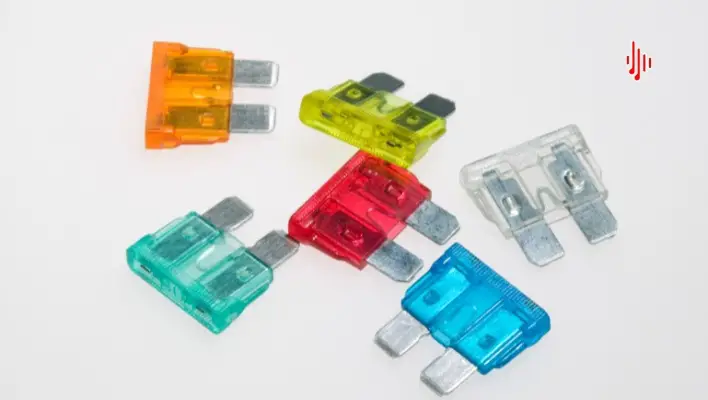Car amplifiers are a great way to boost the sound of your car’s stereo system. They’re also a great way to get louder and more powerful bass than you could otherwise achieve. That is why you need to protect them against any possibility of fire by checking the car amp fuse size chart and equipping your amp with the right fuse.
The most common problem with car amplifiers is that they overheat or overdrive, which causes them to blow. This is why a car amp fuse is important because it helps to protect the car audio system from any kind of electrical faults.
There are different types of car amp fuses available in the market. The main difference between them is their size rating. Those with a higher size rating will have more power capacity while those with a lower size rating will have less power capacity. This is why size is an important consideration when it comes to fuses.
This article endeavors to familiarize you with important aspects of car amp fuses and gives you the car amp fuse size chart to help you choose the right fuse for your car’s amplifier.

What is a Car Amp Fuse
Fuses are small pieces of metal that burn at high temperatures when exposed to electrical current. They protect your car, home or office from dangerous situations by stopping power immediately without causing any damage.
The most common type of fuse is an automotive fusible link, which is a small wire that melts when the current exceeds a certain level. When melted, the fuse cuts off power to prevent damage to other parts of your car’s electrical system.
The car amplifier fuse protects the amplifier from short circuits and overheating and is located on the right side of the engine compartment inside the fuse box. It has a small metal tab that sticks up when it’s installed in your car.
Causes of Car Amplifier Fuse Blowing Up
The most common causes of car amplifier fuse blowing up include:
- Power supply over-voltage. The first thing to check if your amp is blowing fuses is whether there’s any kind of power supply problem that might cause overheating and damage to components within your amplifier.
- Sometimes these fuses fail because of corrosion buildup on their terminals or due to sulfation within the fusible material itself.
- Bad Wiring.
- Overheating.
- Moisture.
If any of these happens, then you should replace the fuse immediately to avoid further damage as well as prevent further failures from occurring in the future.
Types of Amplifier Fuses for Your Car
There are three types of amplifier fuse for your car: Automotive, inline, and inline barrel fuses.
- An automotive fuse is the most common type of amplifier fuse used in vehicles today. These fuses are small flat-leaf-shaped pieces of wire with a lug on one end and a threaded pin on the other. They come in various sizes, ranging from miniature to large.

- Inline fuses are used inside amplifiers or power supplies. The wires that connect to these fuses are usually insulated with the same material as the circuit they protect. Inline fuses have two prongs that protrude from their sides, and they’re usually installed in series with each other to create a circuit for current protection.

- Inline barrel fuses are similar to inline fuses but are designed for high-power applications like electric heaters and industrial machinery motors. They have four prongs instead of two, and they’re held together by a screw thread that allows them to be easily removed from their mountings when needed.
Why is Fuse Size Important?
Fuse size is essential because it determines how much electric current can flow through a wire. The size varies based on the type of application and how much energy is carried by the circuit. If a fuse doesn’t have enough current capacity, it will blow or melt before it has a chance to open.
The primary purpose of a car amp fuse is to protect you and your vehicle from fire or electrical shock by blocking electricity flow in the event of an accident. This is achieved by isolating each part of the system from one another, preventing any component from becoming damaged or overheating.
This means fuses should be sized at the same amperage as the circuit they are protecting. For example, if you’re wiring up a 15-amp circuit, then your fuse should also be rated at 15 amps. The fuse rating for most car amplifiers is 10 amps. However, there are exceptions, with some amplifiers requiring a 20-amp fuse and others 12-amp fuses.
If you want to know whether your car amplifier has a 12 or 20-amp fuse, check the label on the back of your amplifier. The label will tell you what type of fuse it uses and how many amps it should handle safely.
Car Amplifier Fuse Size Chart
Are you asking yourself “what size fuse do I need?” Before getting into this, you must be able to distinguish what the various sizes of fuses mean, which will help you when choosing a fuse size.
A fuse power rating is quite different from that of an amplifier. Whereas most amps are rated in wattage, fuses rating is in amperage. Thus, the 5/10/50 printed on a fuse is 10 A, not 10 W. This is what is referred to as a fuse’s size. Additionally, fuses will be rated by their gauge input given in AWG, which stands for American Wire Gauge.
This chart will give you both units of measuring the size of fuses.
| Total Amplifier Power (all channels) | Fuse Size | Wire Gauge |
| 105 W | 7.5 A | 16 AWG |
| 210 W | 15 A | 14 AWG |
| 240 W | 20 A | 12 AWG |
| 420 W | 30 A | 10 AWG |
| 700 W | 50 A | 8 AWG |
| 1120 W | 80 A | 6 AWG |
| 1440 W | 120 A | 6 AWG |
| 1680 W | 140 A | 4 AWG |
| 1920 W | 160 A | 4 AWG |
| 2160 W | 180 A | 4 AWG |
| 2400 W | 200 A | 2 AWG |
| 3000 W | 250 A | 2 AWG |
| 3600 W | 300 A | 1 AWG |
| 4200 W | 350 A | 1 AWG |
| 4800 W | 400 A | |
| 5400 W | 450 A | |
| 6000 W | 500 A |
Factors Affecting Fuse Size
The size of the car amp fuse is a critical factor in determining its amperage rating. The following factors will determine the maximum amperage rating of your car amp fuse:
1. Amperage Rating
The amperage rating of the fuse determines the size of a car amp fuse. The higher the amperage rating, the larger the fuse will be. Fuses with a lower amperage rating may not be able to carry as much current and could lead to an explosion if they are overloaded.
2. Voltage Rating
If you want to protect something that operates at higher voltages than what your fuse will handle, then you will need to buy heavier-gauge fuses that can handle those higher voltages. You can find these types of fuses in two different sizes – standard and extra heavy-duty (XHD). Standard fuses are usually used in cars and residential applications, while XHD fuses are used in commercial applications with high voltages on electrical circuits.
3. Wire size
The smaller the wire, the higher the current it can carry. For example, a 14-gauge wire can carry up to 30 amps, whereas an 18-gauge can carry up to 50 amps.

How to Select the Right Size Fuse for Your Car
If you’re using an amplifier to boost the sound from your car’s stereo, you’ll need to consider certain things when choosing the correct fuse for your vehicle.
- If you want to use a subwoofer with an amplifier, you’ll need a different fuse than if you’re just using your car’s speakers.
- The same holds true for systems with multiple amplifiers, especially when they’re used with other electronic components such as power boosters and speakers.
- You also need to consider which component might be powered by the current and if you’ll be adding any other components in the future. For example: if you’re adding an aftermarket radio, you may want to size the fuse for that component instead of the power for your accessories.
- Some amplifiers require an amp-specific fuse, while others don’t.
Final Word
There you go; you now have the car amp fuse size chart and know how to determine fuse size. The chart lists the fuse sizes required for each amp with different power ratings, so you shouldn’t make a mistake.
Consult a professional if you have a factory-installed amplifier whose power rating is not listed on your vehicle’s fuse panel. Incase it is an after-market product, be sure to thoroughly check the wattage before installing an amp fuse.
